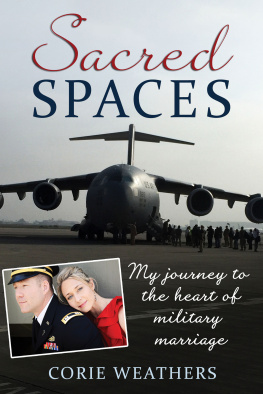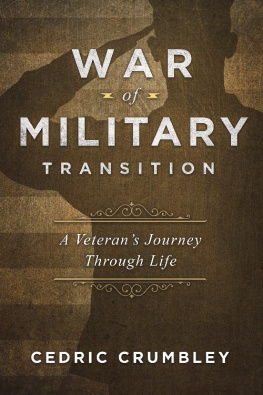Sacred Spaces: My Journey to the Heart of Military Marriage
2016 by Corie B. Weathers. All rights reserved.
Cover photo of Matt and Corie Weathers 2015 Kristin Espinosa.
Cover photo of Boeing C-17A Globemaster III 09-9212 operated by US Air Force 2015 Corie Weathers.
Back cover selfie 2015 Corie Weathers.
Back cover map image @2016 Landsat, map data @2016 Google.
All Bible verse quotes are from The Holy Bible, New International Version (NIV). Copyright 1973, 1978, 1984 by Biblica. All rights reserved.
Editors: Terri Barnes and Marly Cornell
Designers: Andermax Studios and Connie DeFlorin
The views contained in this book are those of the author only
and do not necessarily represent the views of the Chaplain Corps, the US Army, the Department of Defense, or the United States.
Library of Congress Cataloging-in-Publication Data
Names: Weathers, Corie, 1977- author.
Title: Sacred spaces : my journey to the heart of military marriage / Corie Weathers.
Description: St Paul : Elva Resa, 2016.
Identifiers: LCCN 2016021699 (print) | LCCN 2016028310 (ebook) | ISBN 9781934617335 (pbk) | ISBN 9781934617342 (epub ebook) | ISBN 9781934617359 (kindle ebook)
Subjects: LCSH: Weathers, Corie, 1977- | Army spouses--United
States--Biography. | United States. Army--Military life. | Soldiers-
Family relationships--United States. | Afghan War, 2001---Social aspects.
Classification: LCC U766 .W38 2016 (print) | LCC U766 (ebook) |
DDC 958.104/74092 [B] --dc23
LC record available at https://lccn.loc.gov/2016021699
Elva Resa Publishing
8362 Tamarack Vlg., Ste. 119-106, St. Paul, MN 55125
www.ElvaResa.com
www.MilitaryFamilyBooks.com
To Matt:
May this book be the beginning of
actions above words, grace in imperfection,
and new sacred spaces we share together.
To our boys:
May our story reveal to you
just how hard we fought for our family
while serving others.
Contents
Prologue
What began with an invitation to go on a one-week trip to learn more about deployment became a journey that changed my perspective of my military marriage.
In the fall of 2015, US Secretary of Defense Ashton Carter was preparing for a holiday tour to visit troops serving overseas. Realizing that military families have more questions than answers about the deployment experience, Secretary Carters staff wanted to invite a military spouse to go along on this trip to observe, record, and share the experience. Johnny Michael, who was in charge of communications and engagement planning for the secretary of defense, reached out to Kate Dolack, editor-in-chief of Military Spouse magazine, to find a good candidate. Kate offered my name. Earlier that year, I was named the 2015 Armed Forces Insurance Military Spouse of the Year, an award given by Military Spouse magazine for my professional counseling work with military marriages.
In November when I received the invitation to accompany Secretary Carter, Matt and I and our two young sons were preparing for our second move within six months. Although the logistics would be challenging, we agreed I should accept the opportunity. I was honored to be considered and began developing strategies to use the journey to learn more about deployment and better understand its effects on military couples like us.
Before Matt and I were married in 1999, I asked his mother, who had then been married more than twenty-five years, how I would know if I loved Matt enough. My parents had divorced when I was young. Although I was sure Matt was the one for me, I wondered if I knew what it took to sustain a loving, successful relationship for a lifetime. Matts mom told me the kind of love I wanted was not the love I could have right then.
The love you want, she said, doesnt happen until you have made it through some of the worst of what life has to offer. It comes after years of taking care of each other through ups and downs, after raising children together and tending to them when they are sick. It comes after getting jobs and losing jobs, taking care of aging parents, and overcoming the struggles you have as a couple. The love you have now is just the beginning, and perhaps it is enough to begin.
I have carried those words with me, though I didnt recognize their prophetic wisdom until they played out in my own marriage. Matt and I have seen our fair share of ups and downs. Weve obtained jobs and lost jobs, started our family, moved multiple times, gained friends and lost friends. My husbands career as an Army chaplain, which began nine years into our marriage, added another dimension of joys and challenges. But when Matt and I walked down the aisle, we could not have anticipated the stress and impact that deployments and separations would have on our relationship. We didnt know what challenges life would hand us or how to navigate the resentment and hurtthe frequent by-products of conflict. This commitment was not for the faint of heart.
After his first deployment, my husband came home changed. I was different, tooaltered by my own experiences while we were apart. Coming back together after a year of unshared experiences was incredibly challenging. After the second deployment, we learned to navigate around these unshared experiences as if we led double livesour together life and our intermittently separate lives. Learning to love each other through the challenging times, as my mother-in-law suggested, was harder than we expected.
When a service member is deployed, families at home can only try to imagine the life, surroundings, and experiences of their loved one. Service members may describe as much as they can about where they are: the terrain, the bathrooms, meals, living conditions, sights, smells, and people they meet. Even with such descriptions, family members impressions are likely to be mistaken or incomplete. Perhaps service members dont know how to describe aspects of their deployment. Some cant share details for security reasons. Spouses and families may not know what questions to ask, or they might be too consumed with managing life at home to ask any questions. For many reasons, families are often left with a limited picture of deployment, possibly never knowing how far it departs from their service members reality. Military family members at home capture what they can, taking details from their service member, adding images from the news or other sources and putting the pieces together.
I had pictured a particular deployment experience Matt described to me, only to realize later, when he shared the same story in more detail over dinner with friends, that my impressions were completely wrong. Sometimes I heard him tell stories to others that hed never shared with melike the time he said the local monkeys were cute, until they attacked soldiers. I had no idea soldiers came in contact with monkeys in Afghanistan.
Once, Matt mentioned he had a turkey-and-egg-white omelet every morning. Id wrongly assumed he had nothing but powdered eggs for breakfast for a year. I pictured him in a room with walls similar to the walls in our home until I saw a TV documentary showing soldiers surrounded by plywood partitions riddled with bullet holes.
Images matter. Details matter.
In my work as a licensed professional counselor with military couples, as well as in my own marriage, Ive noted that misunderstanding increases when less sensory information is communicated, particularly during deployment. For Matt and me, video calls provided more productive communication than emails or regular phone calls alone.













